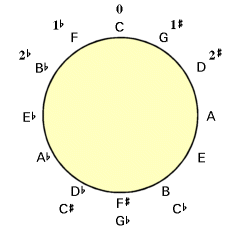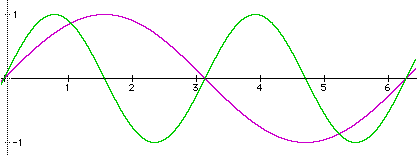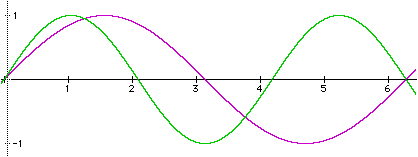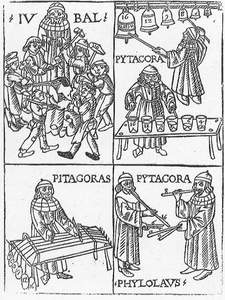Greek Music Theory By Will Bruce
Dorian TTS: virile and bellicose
Phrygian TST: agitated and Bacchic
Lydian STT: intimate and lascivious
(Terpander)
(Pythagoras)~also in use by the Egyptians centuries before.
Major Scale TTS (T) TTS
Dorian (T) Dorian
Nat.Minor Scale TST (T) STT
Phrygian (T) Lydian

Pythagorean Comma =
524288:531441Difference between Ab and G# = 1/60
whereas solar year (360 days) off by 5 1/4 days creates a gap = 1/69.
Just Intervals are those whose frequencies stand in a simple numerical relationship to one another (Keller).
Some just interval ratios� Prime numbers larger than 5 are
according to Pythagoras:
not used in Western music:
1/1 unison *6/7
1/2 octave *7/8
2/3 perfect 5th
*10/11
3/4 perfect 4th
*12/13
4/5 major 3rd
8/9 whole tone (2/3:3/4)
15/16 semitone (3/4:4/5)
Other harmonists:
Aristoxenus:
Harmonika stoicheia (Harmonic elements)Ptolemy: Harmonica (base-60 system [divisible by 2,3,4,5,6,10,12,15,20,30...] ~ prevalent in Babylonian mathematics and throughout the ancient world from 500BC-AD150)
Plato: Republic Bk.VIII
Octave:

Perfect Fifth:

Just Intervals are suitable for monophonic diatonic chant.
Music which modulates into more distant keys encounters some
peculiar problems.
e.g. C-D
> D-E
(maj3rd) C-E
> 4/5 (Pyth. �just� ratio)
12 5ths > 7 octaves
Temperament
(adjusting of intervals) therefore is necessary to play in all keys.
Mean-tone:
8 perfect keys; 4 badly mistuned
Werkmeister:
4 5ths narrowed by � comma (1691); best 3rds F-A &
C-E; good G-B, D-F#, Bb-D;
worse Eb-G, A-C#, E-G#, B-D#. All other 3rds are �wolf�
i.e. cacophonously wide.
Pachebel uses 17 of
24 keys in a set of suites.
Fischer uses 19 in Ariadne
Musica (1715). Organist is given �the thread of Ariadne� as a
guide through the labyrinth of remote keys.
J.S. Bach�s
Wohltemperierte system (1722) of 7 perfect 5ths and 5 tempered
5ths allows comfortable modulation into all 24 keys. cf. http://ha.kellner.bei.t-online.de/
In Bach�s system
each key has a unique series of tonal relationships. Keys were differentiated in
Baroque times by their color and mood:
e.g.
D-maj: festive
F#min: passionately tense
E-maj: because of G# & D#, was
G-maj: quiet and thoughtful
feared and rarely use
�G-min: pathos
E-min: masculine and powerful
A min: masculine, loaded w/ energy
�F-maj &
�C-maj: neutral keys
�Bb-min: dark, heavily veiled
F-min: deep seriousness
B-min: though a tense maj7th to C-maj, Bach gave it
�A-maj: pastoral
consecration in his Mass (BMV232)
Outside of Books I
and II of Das Wohltemperierte Clavier Bach does not use:
C#maj, Db-min, D#min, F#maj, Ab-maj, G#maj, Bb-maj.
Equal
Temperament (the dividing of
the Pythagorean comma into 12 making all tone relationships homogeneous) had
been theorized in Bach�s day but wasn�t feasible before the advent of
electronic tuning devices. In equal temperament, which is the norm today, there
is no inherent difference between keys since all semitones are the same
size. There are no pure (just) intervals except the octave. Based on the
12th root of 2.
Pythagoras�s Tuning Experiments:

� utilized in the musical example: F-maj. 2-part Invention (BMV794) by J.S.B.
� [399a] Plato, Republic
�ll�
kindune�ei
soi
Dvrist�
le�pesyai
ka�
Frugist�.
o�k
o�da,
�fhn
�g�,
t�w
�rmon�aw,
�ll�
kat�leipe
�ke�nhn
t�n
�rmon�an,
�
�n
te
polemik�
pr�jei
�ntow
�ndre�ou
ka�
�n
p�s�
bia��
�rgas�&
prep�ntvw
�n
mim�saito
fy�ggouw
te
ka�
pros�d�aw.
[399a]
but it would
seem that you have left the Dorian
and the Phrygian.
I don't know the musical modes, I said, but leave us that mode that would
fittingly imitate the utterances and the accents of a brave man who is engaged
in warfare or in any enforced business.
� [398e] ibid.
t�new o�n yrhn�deiw �rmon�ai; l�ge moi: s� g�r mousik�w. Meijoludist�, �fh, ka� Suntonoludist� ka� toia�ta� tinew. o�ko�n a�tai, �n d' �g�, �fairet�ai; �xrhstoi g�r ka� gunaij�n �w de� �pieike�w e�nai, m� �ti �ndr�si.
[398e] are the
dirge-like modes of music? Tell me, for you are a musician. The mixed Lydian,
he said, and the tense or higher Lydian,
and similar modes.These, then, said I, we must do away with. For they are
useless even to women who are to make the best of themselves, let alone to men.
�Recounted by Plato [36b] Timaeus �miol�vn
d�
diast�sevn
ka�
�pitr�tvn
ka�
�pogd�vn
genom�nvn
�k
to�tvn
t�n
desm�n
�n
ta�w
pr�syen
diast�sesin,
[36b] And whereas
the insertion of these links formed fresh intervals in the former intervals,
that is to say, intervals of 3:2 and 4:3 and 9:8.
Modern sources:
Bukofzer, Manfred F. Music in the Baroque Era. New York: W.W. Norton & Co., 1947.
Harnoncourt, Nikolaus. Baroque Music Today: Music as Speech. Portland: Amadeus Press, 1982.
Keller, Hermann. Das Wohltemperierte Clavier von Johann Sebastian Bach. B�renreiter- Verlag Kassel, 1965.
http://ha.kellner.bei.t-online.de/ an excellent website giving a detailed bearing plan for the Baroque tuning of harpsichords created by Dr. Herbert Anton Kellner and assimilated from his book: Wie stimme ich selbst mein Cembalo? Schriftenreihe Das Musikinstrument, Heft 19, Verlag Das Musikinstrument, E. Bochinsky, Frankfurt / Main, 31986, ISBN 3-923639-68-6
McClain, Ernest, G. The Pythagorean Plato: Prelude to the Song Itself.
York Beach:
Nicolas-Hays, Inc., 1978.